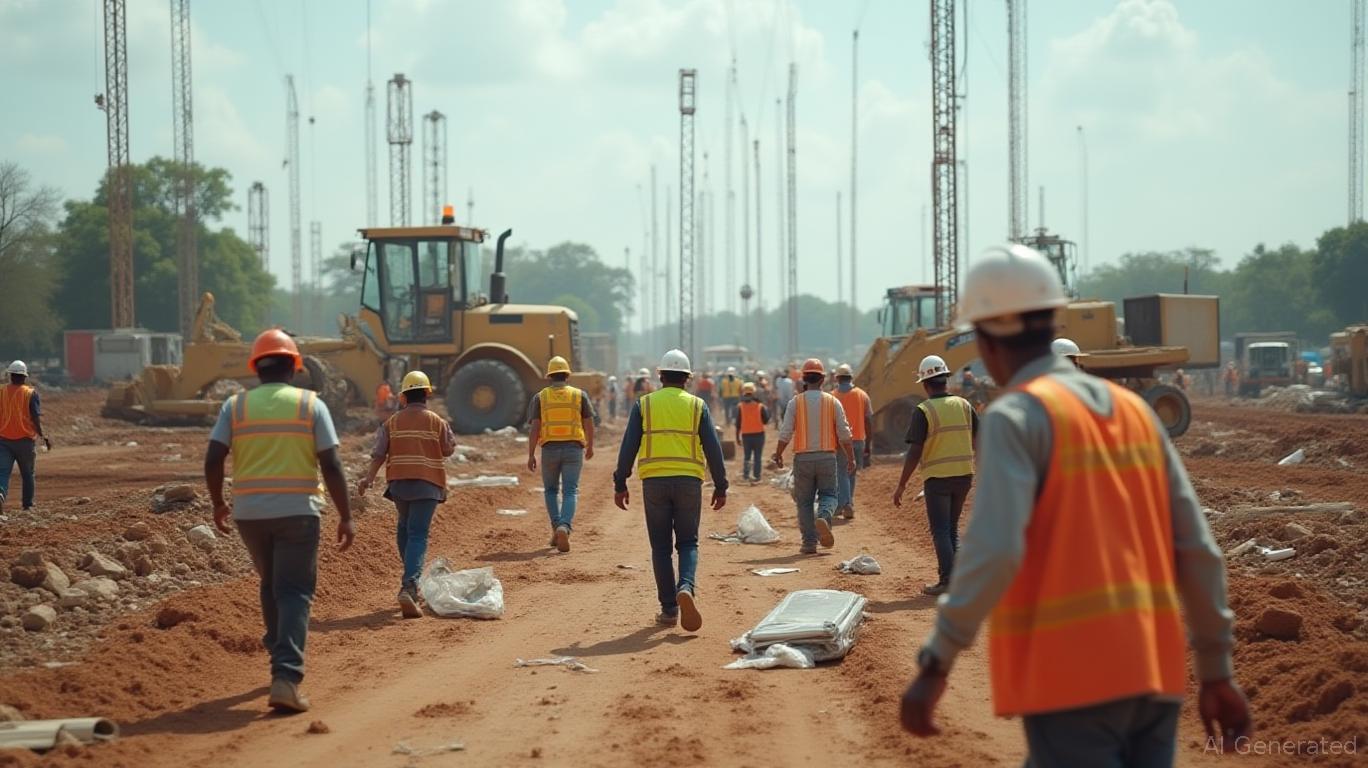ICE Operations Cause Turmoil in Alabama Construction, Triggering Workforce Shortages and Economic Concerns
- ICE raids in Alabama detained 500+ construction workers, worsening labor shortages and delaying projects like Gulf Shores schools and Georgia Hyundai plants. - Industry leaders warn ICE enforcement acts as an "economic shock," raising costs and threatening 200,000 jobs in a $17.2B sector. - 90% of firms struggle to fill roles; 46% report raid impacts, with $84K+ penalties for contractors like Robby Robertson due to 50% crew attrition. - Builders demand legal pathways for skilled workers, citing 439K labo

Alabama’s construction sector is under increasing strain as stepped-up Immigration and Customs Enforcement (ICE) operations disrupt the labor force and pose risks to economic progress. Contractors throughout Baldwin County and other regions have reported abrupt losses of workers, including nearly 50 individuals detained at school building sites in Gulf Shores and Loxley this summer, as well as 475 at a Hyundai electric vehicle facility in Georgia [ 1 ]. Russell Davis from the Home Builders Association of Alabama stated these actions have “undoubtedly impacted the labor market,” worsening pre-existing shortages and causing delays in both housing and infrastructure developments [ 2 ]. Labor economist Anirban Basu described these enforcement efforts as an “economic shock,” leading to higher expenses and a decline in construction quality [ 3 ].
Generating $17.2 billion annually, Alabama’s construction industry supports 200,000 jobs and represents 6.7% of the state’s GDP [ 4 ]. Despite this, industry officials are raising concerns about a labor participation rate of just 57.9% in April 2025—among the lowest in the country—and a 3.0% unemployment rate that hides a critical shortage of skilled labor [ 5 ]. The situation has been aggravated by ICE activity, with 90% of construction businesses in Alabama struggling to hire and 46% reporting direct or indirect effects from raids in the last half year [ 6 ]. Contractors such as Robby Robertson are experiencing project delays and financial setbacks, including one $20 million job now facing an $84,000 cost overrun due to losing half of its workforce [ 7 ].
Industry advocates are reconsidering broad deportation strategies, instead supporting more focused enforcement and legal options for long-term, tax-paying employees. Davis highlighted the importance of a “renewable, employer-sponsored visa” to help stabilize the labor pool, while Tim Harrison from the Associated Builders and Contractors of Alabama suggested a restitution-based approach that would allow undocumented workers to stay [ 8 ]. These recommendations reflect wider initiatives to close a labor gap expected to require 439,000 more workers in 2025, a challenge made worse by an aging workforce and insufficient domestic training [ 9 ].
The economic impact is significant. According to a 2024 Home Builders Institute report, labor shortages led to 19,000 fewer single-family homes being built, worsening the state’s housing affordability crisis [ 10 ]. Economist Bruce Yandle connected ICE-related workforce instability to falling consumer confidence and business outlook, cautioning that this could drive up prices and reduce investment. At the same time, Alabama’s construction sector, which added 4,000 jobs year-over-year, is grappling with higher costs and project delays as companies race to replace experienced immigrant workers [ 11 ].
Effective policy responses remain out of reach. While industry organizations are pressing Congress to expand vocational training in high schools and approve a visa program tailored to construction, the current political environment in Washington prioritizes enforcement over comprehensive reform. The Associated General Contractors of America and the National Center for Construction Education and Research (NCCER) warn that without decisive action, labor shortages will persist into 2026, putting Alabama’s economic growth at risk [ 12 ]. As ICE operations continue, the construction industry’s future resilience will depend on its ability to adapt—through higher wages, cross-training, and collaboration with training providers—to ongoing workforce and policy challenges.
Disclaimer: The content of this article solely reflects the author's opinion and does not represent the platform in any capacity. This article is not intended to serve as a reference for making investment decisions.
You may also like
XRP News Today: IMF Cautions That Tokenized Markets Could Face Collapse Without International Cooperation
- IMF warns tokenized markets risk destabilizing flash crashes due to rapid growth and interconnected smart contracts. - XRP highlighted as potential cross-border payment solution but not endorsed, alongside Stellar and Bitcoin-Lightning hybrid models. - Global regulators intensify oversight of tokenized assets, with ESMA, SEC, and central banks addressing governance and liquidity risks. - IMF stresses urgent need for coordinated policy frameworks to prevent fragmentation and systemic vulnerabilities in ev

Solana News Today: Avail's Nexus Mainnet: A Borderless Blockchain Ecosystem
- Avail launches Nexus Mainnet, a cross-chain infrastructure unifying liquidity across Ethereum , Solana , and EVM-compatible chains. - The platform uses intent-solver architecture and Avail DA verification to replace bridges, enabling seamless asset movement and shared liquidity. - Integrations with major chains and partners like Lens Protocol aim to streamline DeFi and trading, while $AVAIL token coordinates cross-chain transactions. - With Infinity Blocks targeting 10 GB blocks, Nexus addresses liquidit

Cardano News Today: ETFs Turn to Alternative Coins While ADA Stumbles and XLM Gains Momentum with ISO Compliance
- Franklin ETF expands holdings to include ADA , XLM, XRP , and others, reflecting institutional altcoin diversification driven by ISO 20022 compliance and SEC-approved rules. - Cardano faces short-term bearish pressure with 31% monthly decline, contrasting Stellar's bullish 2025/2030 price projections ($1.29–$6.19) fueled by RWA and cross-border payment demand. - ISO 20022 adoption (97% payment instructions) positions ADA/XLM as bridges between DeFi and traditional finance, with Ripple's ILP enhancing XLM
AI Crypto Faces a Pivotal Turn: Regulatory Demands Surpass Aspirations in 2025
